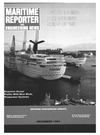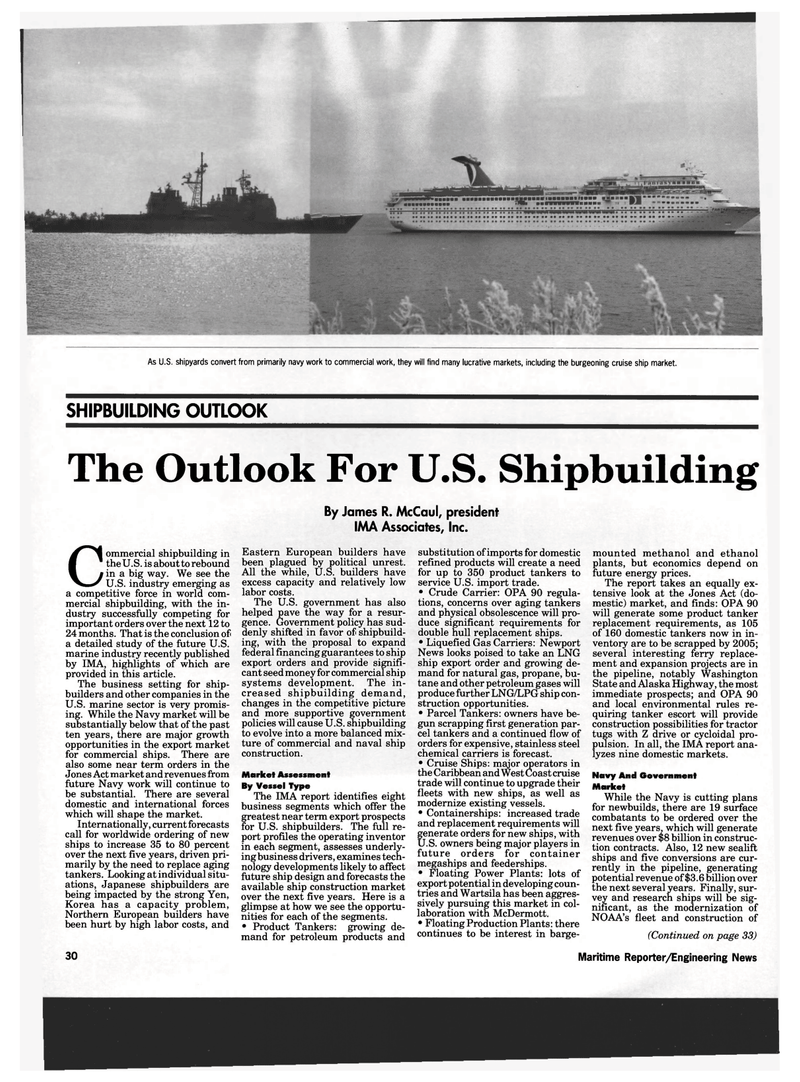
Page 28: of Maritime Reporter Magazine (December 1993)
Read this page in Pdf, Flash or Html5 edition of December 1993 Maritime Reporter Magazine
As U.S. shipyards convert from primarily navy work to commercial work, they will find many lucrative markets, including the burgeoning cruise ship market.
SHIPBUILDING OUTLOOK
The Outlook For U.S. Shipbuilding
By James R. McCaul, president
IMA Associates/ Inc.
Commercial shipbuilding in the U.S. is about to rebound in a big way. We see the U.S. industry emerging as a competitive force in world com- mercial shipbuilding, with the in- dustry successfully competing for important orders over the next 12 to 24 months. That is the conclusion of a detailed study of the future U.S. marine industry recently published by IMA, highlights of which are provided in this article.
The business setting for ship- builders and other companies in the
U.S. marine sector is very promis- ing. While the Navy market will be substantially below that of the past ten years, there are major growth opportunities in the export market for commercial ships. There are also some near term orders in the
Jones Act market and revenues from future Navy work will continue to be substantial. There are several domestic and international forces which will shape the market.
Internationally, current forecasts call for worldwide ordering of new ships to increase 35 to 80 percent over the next five years, driven pri- marily by the need to replace aging tankers. Looking at individual situ- ations, Japanese shipbuilders are being impacted by the strong Yen,
Korea has a capacity problem,
Northern European builders have been hurt by high labor costs, and
Eastern European builders have been plagued by political unrest.
All the while, U.S. builders have excess capacity and relatively low labor costs.
The U.S. government has also helped pave the way for a resur- gence. Government policy has sud- denly shifted in favor of shipbuild- ing, with the proposal to expand federal financing guarantees to ship export orders and provide signifi- cant seed money for commercial ship systems development. The in- creased shipbuilding demand, changes in the competitive picture and more supportive government policies will cause U.S. shipbuilding to evolve into a more balanced mix- ture of commercial and naval ship construction.
Market Assessment
By Vessel Type
The IMA report identifies eight business segments which offer the greatest near term export prospects for U.S. shipbuilders. The full re- port profiles the operating inventor in each segment, assesses underly- ing business drivers, examines tech- nology developments likely to affect future ship design and forecasts the available ship construction market over the next five years. Here is a glimpse at how we see the opportu- nities for each of the segments. • Product Tankers: growing de- mand for petroleum products and substitution of imports for domestic refined products will create a need for up to 350 product tankers to service U.S. import trade. • Crude Carrier: OPA 90 regula- tions, concerns over aging tankers and physical obsolescence will pro- duce significant requirements for double hull replacement ships. • Liquefied Gas Carriers: Newport
News looks poised to take an LNG ship export order and growing de- mand for natural gas, propane, bu- tane and other petroleum gases will produce further LNG/LPG ship con- struction opportunities. • Parcel Tankers: owners have be- gun scrapping first generation par- cel tankers and a continued flow of orders for expensive, stainless steel chemical carriers is forecast. • Cruise Ships: major operators in the Caribbean and West Coast cruise trade will continue to upgrade their fleets with new ships, as well as modernize existing vessels. • Containerships: increased trade and replacement requirements will generate orders for new ships, with
U.S. owners being major players in future orders for container megaships and feederships. • Floating Power Plants: lots of export potential in developing coun- tries and Wartsila has been aggres- sively pursuing this market in col- laboration with McDermott. • Floating Production Plants: there continues to be interest in barge- mounted methanol and ethanol plants, but economics depend on future energy prices.
The report takes an equally ex- tensive look at the Jones Act (do- mestic) market, and finds: OPA 90 will generate some product tanker replacement requirements, as 105 of 160 domestic tankers now in in- ventory are to be scrapped by 2005; several interesting ferry replace- ment and expansion projects are in the pipeline, notably Washington
State and Alaska Highway, the most immediate prospects; and OPA 90 and local environmental rules re- quiring tanker escort will provide construction possibilities for tractor tugs with Z drive or cycloidal pro- pulsion. In all, the IMA report ana- lyzes nine domestic markets.
Navy And Government
Market
While the Navy is cutting plans for newbuilds, there are 19 surface combatants to be ordered over the next five years, which will generate revenues over $8 billion in construc- tion contracts. Also, 12 new sealift ships and five conversions are cur- rently in the pipeline, generating potential revenue of $3.6 billion over the next several years. Finally, sur- vey and research ships will be sig- nificant, as the modernization of
NOAA's fleet and construction of (Continued on page 33) 30 Maritime Reporter/Engineering News

 27
27

 29
29
